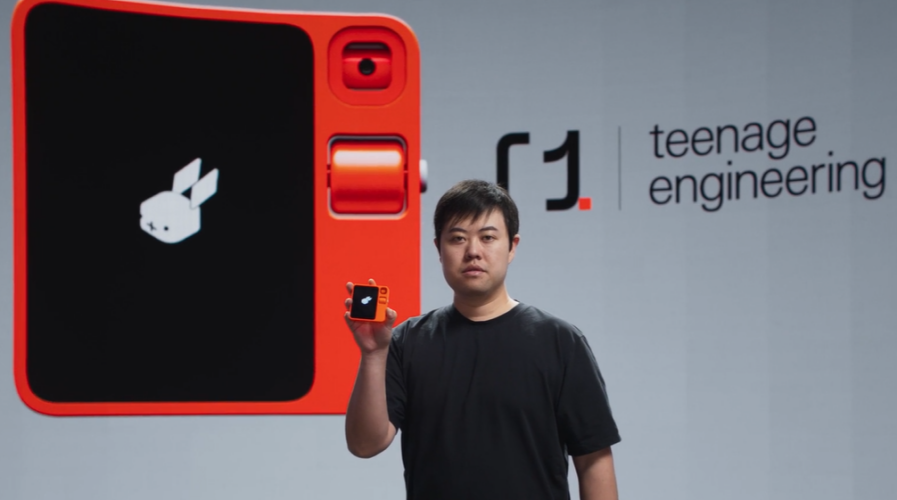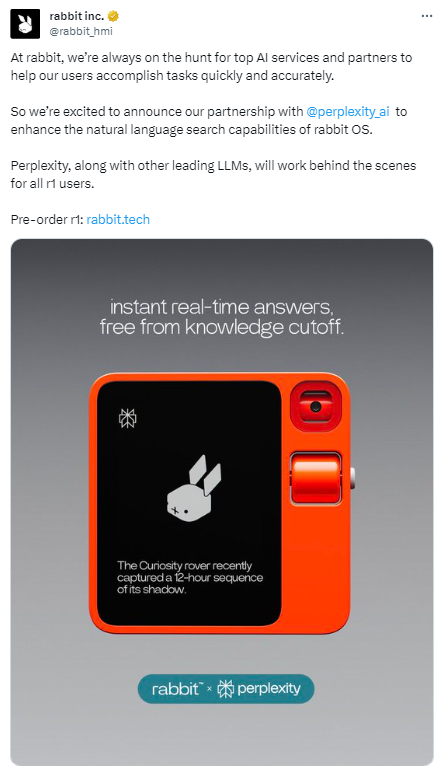
How Rabbit R1 is changing the game. (Source – Rabbit).
What exactly is the Rabbit R1 AI device that confused many people?
- The Rabbit R1 is a compact AI assistant with innovative technology, offering app integration and a versatile, user-friendly experience.
- Rabbit’s R1 revolutionizes personal tech with its unique AI, seamlessly integrating with various services for a more efficient experience.
- Rabbit’s collaboration with Perplexity enhances the R1’s capabilities.
Have you heard about the Rabbit R1, the latest must-have in tech circles online? This innovative device brings to mind the compact and stylish Divoom portable Bluetooth speaker, known for its retro pixel art display. Designed to fit in your palm comfortably, the Rabbit R1 stands out not only for answering questions but also for its ability to launch a Spotify playlist.
What is Rabbit R1?
The Rabbit R1, contrary to initial assumptions, is not a smartphone – or indeed anything akin to the technologically advanced Rabbit that is a friend to almost half of the Western world. Instead, its purpose is to serve as a dedicated AI-powered personal assistant. Jesse Lyu, the CEO and founder of Rabbit, an AI startup, says the device isn’t intended to replace smartphones – at least not in the immediate future.
Making its debut at CES 2024, the Rabbit R1 is a US$199 handheld AI assistant. Its design, a collaborative effort with Teenage Engineering, features a walkie-talkie-like square shape and a vibrant orange color, contributing to its retro aesthetic. The device is packed with a range of features, including a 2.88-inch touchscreen, a camera, a control wheel, speakers, microphones, 4GB of memory, 128GB of storage, and a 2.3GHz MediaTek processor.
Despite its compact size, being approximately half the size of an iPhone 15 and remarkably lightweight, the Rabbit R1 is unique in its operation. It does not rely on in-built apps but instead connects to apps on your smartphone. The highlight of the R1, as reported by The Verge, lies in its software – Rabbit OS and the underlying AI technology. Rabbit OS utilizes a “Large Action Model” (LAM), differentiating itself from typical ChatGPT-style language models. This LAM serves as a universal controller for various apps, offering a versatile solution to manage services across websites, apps, or other platforms.
Jesse Lyu emphasizes that the R1 aims to provide a less distracting digital experience. It comes equipped with a dedicated training mode that allows users to tailor interactions with specific commands, which the device remembers and executes. This customizability and memory function are critical to the R1’s user-centric design.
The adaptability of the Rabbit R1 is a significant feature. Its LAM is engineered to learn from and interact with new applications, extending the device’s functionalities beyond pre-installed apps. This adaptability makes the R1 a tool capable of accommodating various user interfaces and tasks.
In its essence, the Rabbit R1 is akin to popular devices like Alexa or Google Assistant. Through Rabbit OS, it can manage various tasks such as playing music, ordering a car, buying groceries, sending messages, and more, all via a single, streamlined interface. The interface displays category-based cards for different functions, with the screen primarily serving to confirm the model’s output.
One of Rabbit’s innovative approaches is integrating with existing apps. Instead of developing numerous APIs and seeking developer support for the R1, Rabbit trained the LAM through direct human interaction with popular apps like Spotify and Uber. This training approach enables the LAM to recognize functionalities and apply its knowledge across various apps.
The R1’s practical applications extend to its training mode, where users can teach the device to perform specific tasks. For example, Lyu describes how the device can be taught to remove watermarks in Photoshop, a process that Rabbit OS can learn in just 30 seconds and then apply autonomously in future tasks.
Challenges and future prospects
But questions arise regarding the practical application of these features. The Verge points out that while some tasks can be performed directly on the R1, a web portal called Rabbit Hole is utilized for accessing various services. Additionally, teaching the R1 to use complex applications like Photoshop involves using Rabbit’s virtual machines, which may present challenges in accommodating diverse users and platforms.
The Rabbit R1’s purpose, while multifaceted, is not entirely clear-cut. It’s not designed to replace a phone but does offer capabilities such as video calls and support for a SIM card. Primarily functioning as a voice assistant, it also includes a screen and camera. Despite this array of features, Rabbit has prioritized security and privacy in the design of Rabbit OS, even though it requires users to log into commonly used services.
Rabbit’s strategy in the tech market is intriguing, as it bypasses the traditional need for extensive operating system support by teaching its model to use existing apps. In the context of new AI-powered hardware, the Rabbit R1 stands out as a super app – a single interface offering many functionalities. Rabbit envisions Rabbit OS as an alternative to the traditional app store, similar to the role ChatGPT could play in web search. This vision, while ambitious, is not without its challenges and complexities.
Lyu anticipates shipping the Rabbit R1 in March, hoping to outpace competitors like Humane’s AI Pin. Despite the surging interest in this new technology, Rabbit has announced that its fourth pre-order batch has already sold out.
In a recent development, Rabbit announced a collaboration with Perplexity, with plans to integrate the “conversational AI-powered answer engine” into the R1. This partnership sets the R1 apart from standard large language models (LLMs) by featuring a built-in search engine that provides live, up-to-date answers without any knowledge cutoff.
Collaboration with Perplexity and enhanced search capabilities
During a live Spaces broadcast, Perplexity co-founder Aravind Srinivas and Rabbit’s CEO revealed that the first 100,000 Rabbit R1 units will come with a one-year subscription to Perplexity Pro. This premium plan usually costs US$20 per month and includes access to advanced LLMs such as GPT-4.
Rabbit’s statement on X confirmed that Perplexity will work alongside other leading LLMs on the R1, offering this advanced functionality without needing a subscription.

Rabbit announces partnership with Perplexity (Source – X),
The Rabbit R1, with its 2.88-inch touchscreen, scrolling navigation wheel, and rotating camera, is a compact, pocket-sized device designed to control various apps. Powered by its “Large Action Model” AI, the R1 is proficient in tasks ranging from sending messages and selecting songs to making online orders.
Perplexity AI combines search capabilities with LLMs like OpenAI’s GPT-3.5, positioning itself as a formidable competitor against established players like Google and Bing and other emerging AI-driven search engines.
READ MORE
- 3 Steps to Successfully Automate Copilot for Microsoft 365 Implementation
- Trustworthy AI – the Promise of Enterprise-Friendly Generative Machine Learning with Dell and NVIDIA
- Strategies for Democratizing GenAI
- The criticality of endpoint management in cybersecurity and operations
- Ethical AI: The renewed importance of safeguarding data and customer privacy in Generative AI applications


